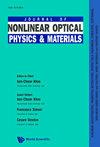Optimising aerosol jet printing of collagen inks for enhanced piezoelectricity and controlled surface potential
IF 2.3
4区 物理与天体物理
Q2 OPTICS
引用次数: 0
Abstract
Collagen is a highly versatile protein used in tissue engineering constructs and as a model piezoelectric biomaterial. The piezoelectricity of collagen can be enhanced through the alignment of collagen domains and fibres, although most fabrication techniques used to form dense collagenous constructs do not allow for significant collagen alignment. The use of aerosol jet printing (AJP) mitigates the limitations of using soluble collagen inks for bioprinting or extrusion-based 3D printing, particularly if microfibrillar collagen suspensions are used as a cost-effective and scalable ink source. In this work, Type I and Type II microfibrillar collagen from different anatomical sources were successfully deposited using AJP with two different atomisation methods, namely pneumatic-AJP (p-AJP) and ultrasonic-AJP (u-AJP). The printing parameters were optimised for their piezoelectric amplitude and surface potential. Fourier transform infrared spectra of the films revealed that ultrasonic atomisation did not cause notable denaturation of collagen, although the process resulted in the fractionation and preferential deposition of the oligomeric and gelatinous components within the slurry. The printed collagen samples displayed a piezoelectric response that was four times higher than the values obtained from drop-cast collagen films, and their surface potential was found to be positively correlated to the roughness of the films which can be controlled through the mode of atomisation. These results indicate the ability to enhance and control the piezoelectricity and surface potential using p-AJP and u-AJP, which offers a promising physical modulation technique to tailor cell adhesion, proliferation or differentiation for collagen-based tissue engineering constructs.优化胶原蛋白油墨的气溶胶喷射打印,以增强压电性和控制表面电位
胶原蛋白是一种用途广泛的蛋白质,用于组织工程结构和模型压电生物材料。胶原蛋白的压电性可以通过胶原结构域和纤维的排列来增强,尽管大多数用于形成致密胶原结构的制造技术不允许显著的胶原蛋白排列。气溶胶喷射打印(AJP)的使用减轻了在生物打印或基于挤压的3D打印中使用可溶性胶原蛋白油墨的局限性,特别是如果使用微纤维胶原蛋白悬浮液作为成本效益高且可扩展的油墨源。在这项工作中,使用两种不同的雾化方法,即气动-AJP (p-AJP)和超声-AJP (u-AJP),成功地沉积了来自不同解剖来源的I型和II型微纤维胶原。对其压电振幅和表面电位进行了优化。薄膜的傅里叶变换红外光谱显示,超声波雾化并没有引起胶原蛋白的明显变性,尽管该过程导致了浆液中低聚物和凝胶成分的分离和优先沉积。打印的胶原蛋白样品显示出的压电响应比滴投胶原蛋白薄膜高四倍,并且发现它们的表面电位与薄膜的粗糙度呈正相关,这可以通过雾化模式来控制。这些结果表明,使用p-AJP和u-AJP可以增强和控制压电和表面电位,这为基于胶原的组织工程构建提供了一种有前途的物理调制技术,可以定制细胞粘附、增殖或分化。
本文章由计算机程序翻译,如有差异,请以英文原文为准。
求助全文
约1分钟内获得全文
求助全文
来源期刊
CiteScore
3.00
自引率
48.10%
发文量
53
审稿时长
3 months
期刊介绍:
This journal is devoted to the rapidly advancing research and development in the field of nonlinear interactions of light with matter. Topics of interest include, but are not limited to, nonlinear optical materials, metamaterials and plasmonics, nano-photonic structures, stimulated scatterings, harmonic generations, wave mixing, real time holography, guided waves and solitons, bistabilities, instabilities and nonlinear dynamics, and their applications in laser and coherent lightwave amplification, guiding, switching, modulation, communication and information processing. Original papers, comprehensive reviews and rapid communications reporting original theories and observations are sought for in these and related areas. This journal will also publish proceedings of important international meetings and workshops. It is intended for graduate students, scientists and researchers in academic, industrial and government research institutions.

 求助内容:
求助内容: 应助结果提醒方式:
应助结果提醒方式:


